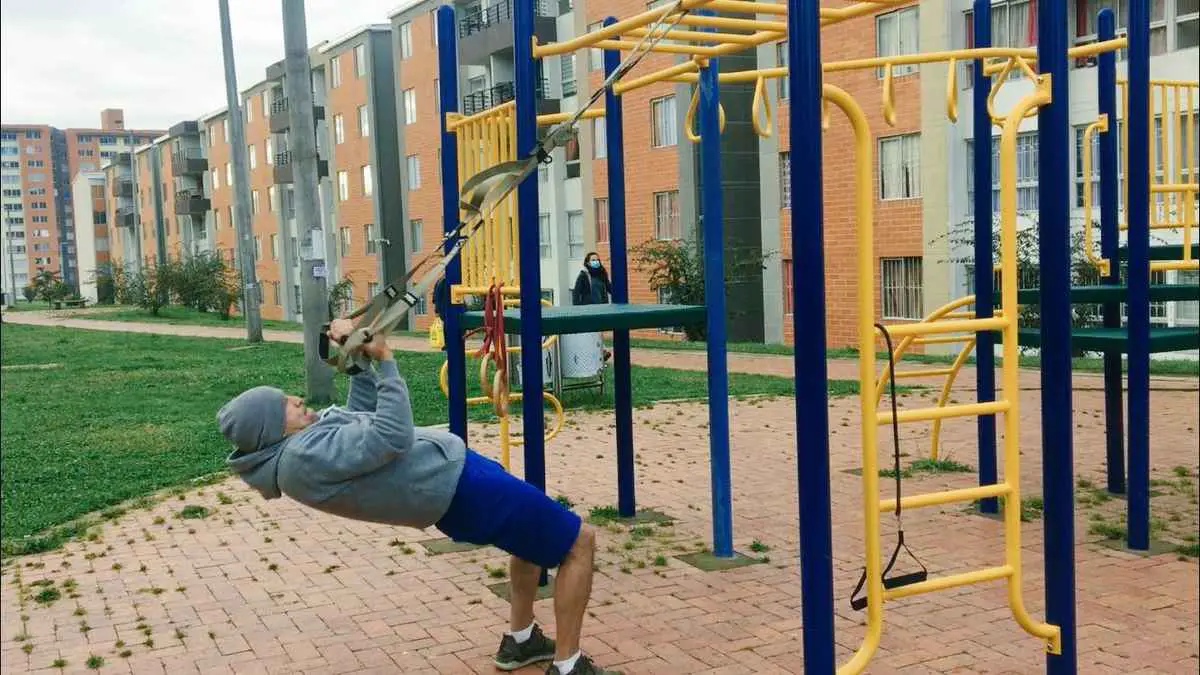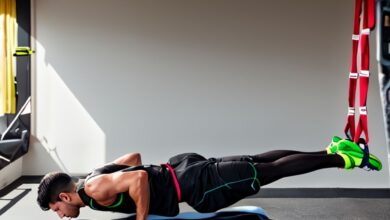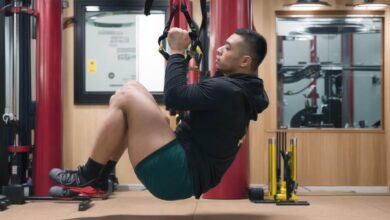- Intelligent weight technique in TRX bicep workouts.
- How to create variations in TRX bicep exercises.
- Bicep curl with single and double anchor points.
- Hybrid bicep exercises with TRX and weights.
TRX bicep workout is a no-weight bicep workout with suspension straps. Like other calisthenics exercises, TRX bicep curl uses body weight as a source of resistance to work out biceps. Many of the TRX bicep workouts introduced in this article are new and innovative.
We tried to cover every possible variation of TRX bicep workouts. With applicable information about how to create different variations of bicep curl using suspension straps, you should be able to design a proper training plan based on your needs.
No time or financial resources for gym membership? Or you might be one of those people who think gym is not for them. Sometimes age, other times personal issues, such as injury or inability. With the help of TRX suspension trainer, all you need is your bodyweight and a small space to have a perfect workout. In fact, suspension straps eliminate the barriers of time and fitness apparatuses to have a perfect exercise.
Table of Contents
8 Trx Bicep Curl Benefits
TRX bicep curl brings similar benefits to the bicep curl with weights. Apart from that, it has some added benefits that are exclusive to suspension straps, which cannot be gained by barbells and dumbbells.
- TRX bicep curl is an effective way to build bicep muscle. Biceps muscle, also known as biceps brachii or two-headed muscle, has two parts of long head and short head. With TRX, you can properly exercise both parts at different angles.
- TRX bicep curl improves elbow flexion. Bending the elbow toward the bicep is elbow flexion, and the opposite movement is elbow extension. Freedom and full range of movement in TRX bicep curl improve the functionality of elbow flexion in daily activities.
- TRX bicep curl increases grip strength. Brachioradialis muscle in the forearm is responsible for handgrip. TRX bicep curl exercises improve grip strength, which is required in compound exercises such as TRX pull-ups.
- Aesthetics. TRX bicep curl workouts exercise biceps in all angles and positions, which translates into a well-rounded and proportionate shape.
- TRX bicep workouts add variety to your gym routine. For weight lifting athletes that require some variety in their exercise, TRX bicep exercises add new challenges to the routine.
- TRX bicep workout is a low-impact activity. Performing bicep curls with weights can put high impact forces on wrist or elbow joints. For example, bicep curl on preacher bench at maximum elbow extension can impose mechanical stress on the elbow joint. In TRX bicep curl, at the full extension of the arm, there is no jarring impact on the elbow, which makes it a better alternative for injury recovery too.
- No need for weights, apparatus, and space. Like all other TRX exercises, you can practice TRX bicep workout in almost any environment, any time.
- It is beginner-friendly. Seniors, kids, and people with disabilities at all fitness levels who cannot go to the gym or lift weights can benefit from TRX to build biceps.
How to Do TRX Bicep Curls?
Since the resistance on the biceps is created by body weight, we should put our body in a declining situation. For this purpose, apply TRX high anchor point. In TRX bicep curl, we should adjust the strap length in a way that it forms a downward slope from TRX anchor point towards shoulders. So, we don’t look for a specific strap length.
- Grab TRX handles with underhand grip.
- Arm position in TRX bicep curl forms a slope as an extension of suspension straps.
- Determine your starting position by flexing elbows and bringing handles close to your shoulders.
- To create initial resistance, you need to lean backward. This can be achieved in two ways:
- Move one step forward.
- Bend your upper body a little backward, enough to produce initial resistance.
Once you find your sweet spot, keep this position throughout the entire exercise. After each repetition, you will return to his position.
- For the first move, fully extend your arms. At this point, you want to locate the proper positioning of your feet.
- Two types of foot positioning in TRX biceps workout:
- Both feet are parallel to each other.
- One foot is partially in front of another.
The second position gives more control during the exercise, and we have a better opportunity to make use of “Intelligent weight.”
- Your initial position has a little backward slope, and it produces very little resistance. This is where you can apply intelligent weight technique to create more resistance. Push your toes to the ground and simultaneously drop your weight backward.
- Once you are at the full extension of biceps, start the concentric muscle contraction.
- After a few repetitions, due to muscle fatigue, starting from a fully extended position can become difficult. At this position, if you choose foot position Type B, with the help of your back foot, you can assist the bicep curl, which is another usage of intelligent weight.
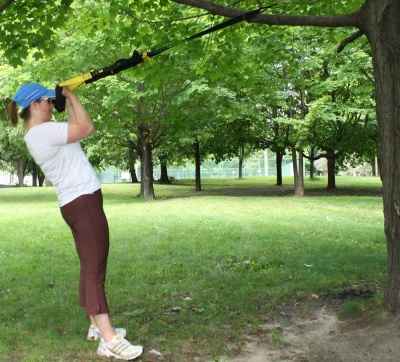
Starting position in TRX is very important. It determines how accurate or wrong you perform the exercise. So, adjust the angle of the body, feet positioning, etc., from the beginning and follow the trend during the entire workout.
“Intelligent weight” is a concept pioneered by Training Bodyweight. It involves implementation of different techniques to make micro-adjustments in the amount of resistance on the target muscle.
For more information about the concept of “intelligent weight,” study Different types of muscle contractions in TRX suspension training.
What Muscles Work During TRX Bicep Curl?
The biceps brachii muscle is the primary mover during the TRX bicep curl exercise. This muscle is attached to the shoulder blade from two areas, and because of this configuration, it is called biceps, which means two heads. Biceps brachii is responsible for elbow flexion and supination of the forearm. You can emphasize biceps brachii by supinated or underhand grip in TRX bicep curl, also known as TRX bicep curl.
Having said that, this is the reason why TRX bicep curl is the primary exercise for biceps. However, it’s not the only muscle that works during the TRX bicep curl. Brachialis and brachioradialis are two smaller muscles that work during TRX bicep workout.
The brachialis muscle is located under the lower part of bicep brachii. Brachialis only acts to flex the elbow. To put isolated emphasis on this muscle, practice pronated or overhand grip in TRX reverse grip bicep curl.
Brachioradialis muscle is located at the outer side of the forearm and the lower arm, and its only function is elbow flexion. To emphasize brachioradialis muscle, practice with neutral grip, such as in TRX bicep hammer curl.
Several stabilizer muscles are also activated during TRX bicep curl, such as the anterior deltoid that is responsible for flexing the shoulder. Particularly, when we assist the bicep curl by raising the arm upwards. It also activates other muscles of the forearm that are responsible for extension and flexion of the wrist and fingers.
TRX Bicep Curl Variations
Studies show that different people respond differently to the same exercise. This alone is a good reason to add variations to your TRX bicep curl. Maybe you respond to some forms of exercise better than other forms.
Also, studies indicated that adding variation to the exercise brings better results in strength gain than just increasing the resistance. This is especially important in bodyweight exercises, where the resistance is confined to the weight of our body.
Adaptive resistance is a well-known phenomenon amongst fitness enthusiasts that hinders progress. Adaptive resistance is when you perform a certain exercise for a long time so that your body no longer responds to it. Changing exercises every so often gives muscles an extra stimulus to progress further.
Furthermore, performing the same exercise over a prolonged period of time increases the risk of injury. Using the same muscle with the same pattern or angle increases wear and tear of the soft tissues in the area.
Nevertheless, perhaps the most important reason to add variety to the exercise is to avoid non-uniform hypertrophy. Each exercise activates a certain part of the target muscle more than other parts. Over time, this leads to unbalanced muscle growth, also known as nonuniform hypertrophy. Therefore, for a well-balanced, rounded physique, we should add variety to each exercise.
Similar to traditional weight lifting, we can have different TRX bicep curl variations by changing angles and grip positions.
1. TRX Reverse Grip Bicep Curl
In TRX reverse grip bicep curl, grab handles with overhand grip or pronated hand position. Everything else is similar to simple TRX bicep curl. To add to the intensity and effectiveness of the exercise, you can hold for 2 seconds in fully contracted position.
2. TRX Bicep Hammer Curl
- For TRX hammer curl, grab TRX foot cradles or grab the straps from above handles.
- Use a neutral grip position. Your fists should look like a hammer during extension and flexion moves.
- Determine your starting position, including feet placement and angle of the body.
TRX bicep hammer curl can be performed with both single anchor point and double anchor points.
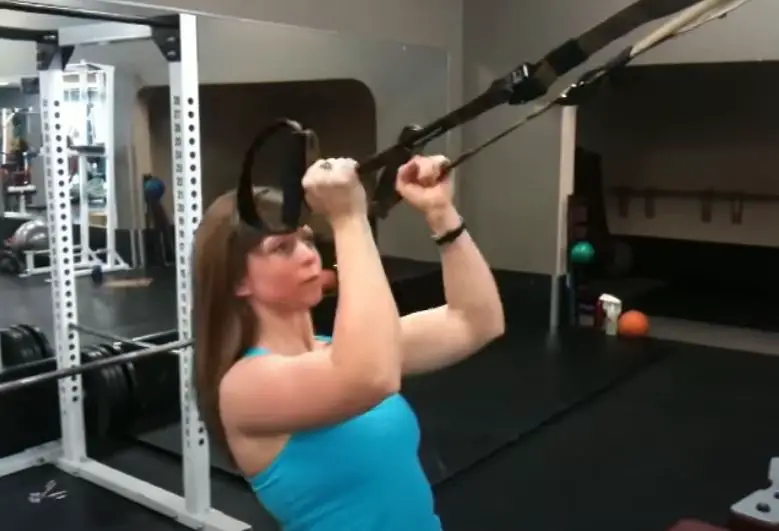
3. TRX Zottman Curl
TRX zottman curl combines supinated (underhand) grip with pronated (overhand) grip in one exercise. In other words, It’s a combination of TRX bicep curl and TRX reverse grip bicep curl.
How do you do Zottman curls with TRX:
- Adjust your starting position similar to TRX bicep curl.
- Start with underhand grip and flex elbows.
- At the top of the motion, rotate your palms into overhand grip.
- Start extension move until arms are fully extended.
- At maximum extension, rotate your palms into underhand grip.
- Repeat.
The video below demonstrates zottman curl with dumbbells. The same principles apply to TRX zottman curl.
4. TRX Twisting Curl
- Similar to TRX zottman curl, in TRX twisting curl, start with hammer grip with your arms extended.
- Begin flexion move while twisting your hands into underhand grip.
- Return to the extended state while twisting your hands back into hammer grip.
Difference between TRX twisting curl and TRX zottman curl:
- In zottman curl, you rotate the handles at two ends of the movement, but in twisting curl, you should twist during the movement.
- Due to the biomechanics of TRX twisting curl, it is more suitable to start with a hammer grip position, but if you grab TRX foot loops instead of handles, you can start with supinated or pronated position.
5. TRX Inverted Biceps Curl
TRX inverted bicep curl is similar to simple TRX bicep curl, except the trainee’s position is right below the anchor point. Therefore, the suspension strap stands almost vertically below the anchor.
- Knees can be straight or bent; both variations are possible.
- Body position is almost horizontal to the floor.
- Arms fully extended with handles in hands, and from there, start the flexion movement.
TRX inverted biceps curl is a relatively advanced mode of simple TRX bicep curl. A large portion of body weight hangs from the arms in this exercise. Sometimes using intelligent weight techniques can be inevitable. In this case, we can get help from legs to push the body upwards.
The main difference between TRX inverted bicep curl and TRX bicep curl is in the resistance at the flexion state. In TRX bicep curl, in the complete flexed state, the resistance is minimum; but in TRX inverted biceps curl, it is maximum.
Different grip positions for TRX inverted bicep curl:
- Underhand grip
- Overhand grip
- Neutral grip
- TRX twisting curl
6. TRX Bicep Clutch Curl with 18 Variations
- Find your starting position with TRX in your hands and knuckles touching the chest.
- Lean backward to the full extension of arms until both your palms face each other.
- Flex your elbows and bring your knuckles close to your chest.
TRX bicep clutch curl can be in three forms:
- Hands get close to the chest with fists in front of each other.
- TRX crossing clutch curl. Hands get close to the chest in a crossing position with one arm above the other alternatively.
- Using TRX double anchor points. Use two separate TRX suspension straps or extend both arms of TRX and anchor them from two widely separated locations. Compared to single anchor point, double anchor points provide a better position to perform this exercise.
Each form of TRX bicep clutch curl can be performed in four main grip positions and some combinatory forms. Here we have 3×6=18 variations of TRX bicep clutch curl.
- Underhand grip
- Overhand grip
- Neutral grip or hammer shape grip
- Zottman curl
- TRX twisting curl
- TRX clutch curl + TRX bicep curl. Flexion phase in clutch curl form and extension phase in simple TRX bicep curl and vice versa.
7. TRX Bicep Curl Crunch or TRX Seated Bicep Curl
- To perform TRX bicep curl crunch, have a sit on the ground.
- Knees can be slightly bent or with straight legs on the ground.
- Determine your sitting position in a way that while your arms are fully extended, your back is slightly above the floor. This is to make sure that your biceps are engaged throughout the entire movement, and you don’t take rest. Besides, it allows a nice stretch of arms and back muscles at that point.
- At the start of the extension motion, where the body is in upright position, the resistance might be low. So, take advantage of the intelligent weight technique by using lower back muscles and pushing your torso backward until gravity takes the lead.
Different variations of TRX seated bicep curl:
- Underhand grip
- Overhand grip
- Neutral grip
- Zottman grip
- TRX switching curl
- Seated TRX bicep clutch curl (with all different forms).
- TRX seated bicep curl can be practiced with high anchor point, as well as low-middle anchor point.
8. TRX Bicep Workouts with Double Anchor Points
All TRX bicep workouts with single anchor point can be performed with double anchor points too. In bicep exercises, the main difference between the single anchor and double anchor suspension straps is the distance between the handles. Single anchor straps naturally drive handles close to each other, leading to a narrow grip position. On the contrary, dual anchor straps drive handles apart, leading to a wide grip position.
Regardless of grip position, TRX bicep workouts with double anchors can have three major variations.
- Starting position is at wide handle grip, and then forearms fold over biceps. Elbows Keep their position.
- Starting position is at a wide handle grip, and then handles move towards the center of body into a narrow grip position. Elbows point to a 45° angle at that point.
- Elbows remain in line with the chest while handles get close to each other. This exercise is TRX bicep clutch curl.
Double anchor points exercises can be with high anchor points or low anchor points. All TRX bicep workouts can be performed with high double anchor points, but some of them – not all of them – can be performed with low double anchor points.
For more information about single anchor and double anchor suspension trainer, study TRX anchoring solutions.
9. TRX Single Arm Bicep Curl
TRX bicep curl single arm is a variation of TRX bicep curl with only one arm engaged. Similarly, adjust your proper positioning and grab one handle with one hand. Perform 8-15 repetitions with that arm, then switch arms and do another 8-15 reps.
We can apply all forms and variations of TRX bicep workouts in TRX single arm bicep curl, including different grip positions and elbow positions (vertical, 45°, etc.). Apart from that, TRX single arm bicep curl has also other exclusive variations too.
1) TRX Single Arm Bicep Curl — One arm at a time
- Grab handles with both hands.
- Start with one hand and perform a full repetition while the other hand takes rest.
- Start with another hand and perform one repetition while the other hand takes rest.
- Alternate hands.
We can apply all forms of TRX bicep workouts to this exercise, with double anchors or single anchor.
2) TRX Single Arm – Single Leg Bicep Crossover
- Hold one TRX handle with one hand.
- The foot opposite to that hand should remain on the ground.
- Lift the foot which is at the same side of the hand.
- Do TRX single arm bicep crossover.
3) TRX Side Bicep Curl
TRX side bicep curl is a variation of TRX single arm bicep curl, where the body is positioned in a way that one side is towards the strap. Apart from all the aforementioned hand positions, it has two different elbow positions:
- Low elbow, which is the natural form of TRX side bicep curl.
- Horizontal elbow
- High elbow, in which the elbow is above the hand.
In high elbow TRX side bicep curl, the elbow is above, and the hand is below. This variation is the reverse of low elbow TRX side bicep curl. High elbow TRX side bicep curl requires low-middle anchor point. Because the elbow is situated above, high anchor point restricts the freedom of movement.
4) TRX Kneeling Side Bicep Curl
TRX kneeling side bicep curl is similar to TRX side bicep curl, but here you kneel down and put one knee onto the ground. The rest is the same.
10. TRX Eccentric Bicep Curl
Concentric and eccentric muscle contractions are two phases of a full repetition. Concentric contraction is the positive phase, and it is when you bring a weight up and shorten your muscle. On the contrary, eccentric muscle contraction is the negative phase of movement, and it is when you bring the weight back down, which lengthens your bicep muscle.
TRX eccentric bicep curl implements the same principle. Normally, we put the focus of TRX bicep exercise in the concentric contraction, whereas in the TRX eccentric bicep curl the emphasis is on the negative phase. That means, we overload the muscle at the flexed position and allow the extension of the arm under control.
How to do TRX eccentric bicep curl?
- Adjust your starting position while your elbows are flexed. The angle of the body should be enough to produce extra resistance against the arms. So, your initial body position is not entirely vertical
- Drop your body weight backward with a little push by using your feet. Start the eccentric movement with control until your arms are fully extended.
- Start the concentric movement and take your body to the initial position.
Take note that in TRX eccentric bicep curl, you want to overload your muscle so that elbows extend while you resist it. You don’t want to miss that overload at the initial position. Hence, your starting position should create enough weight to force your arms wide open. High anchor point provides a better setting for TRX eccentric bicep curl.
Implementing intelligent weight technique is inevitable during TRX eccentric bicep curl. For this, you need to put one leg backward, which supports your weight when it is necessary. At the fully extended arm position, probably your body angle is sharp and produces more weight than the biceps can handle. So, you need some help with your supporting back leg to bring your body back to the initial position. The help of your back leg should not be too much to make the movement easy. Rather, it should be enough to allow you to drive your body forward with the power of your biceps. Still, the biceps should do more than 80 percent of the work and remain under pressure all along.
That being said, TRX bicep curl is indeed TRX concentric bicep curl. All variations of simple TRX bicep exercise apply to TRX eccentric bicep curl.
11. TRX Pelican Curl
TRX pelican curl is a TRX bicep curl alternative that mostly focuses on the eccentric phase of bicep curl.
- Hang TRX from a high anchor point. Position yourself almost underneath the anchor point and have TRX handles at heap height.
- At the starting position, elbows are flexed and ready to start the eccentric move. Lean forward and allow your body weight to gradually extend your arms backward until they reach the fully extended state.
- Start concentric move by flexing elbows and bringing the body back to its initial position.
You may use intelligent weight technique by stepping one foot forward. Employing a supporting leg can be during the eccentric or concentric phase. Another way to make use of intelligent weight technique is by bending forward. In doing this, keep the lower body still but hinge from hips to create resistance.
The harder variation of TRX pelican curl is when the body is parallel to the ground at the starting position. Subsequently, by placing the feet in an upper position compared to the torso, we can make the exercise even harder.
Different variations for TRX pelican curl
- Underhand grip – Elbows down
- Overhand grip – Elbows down
- Zottman grip – Elbows down
- Clutch curl grip – Elbow at chest height – Including different grip positions
- Leaning forward with straight body
- Bending upper body forward
TRX pelican curl can be practiced with single and double anchor points. Some variations of TRX pelican curl, such as clutch curl grip, are more suitable for double anchors. However, we can practice clutch grip with single anchor too. Similar to TRX bicep clutch curl, in this variation anchor points are wide apart, and elbows are positioned at chest height. By leaning forward, arms will be extended to both sides of the body. This form of TRX pelican curl is similar to TRX chest exercises, but movement is limited to elbow joints and not chest muscles.
12. TRX Hinge Bicep Curl
TRX hinge bicep curl or TRX overhead bicep curl is another innovative variation of TRX bicep workouts. Contrary to simple TRX bicep curl, for TRX hinge bicep curl, we bend our body forward in a hinge position and keep it in that state. The idea is to have elbows at a position above the head, so that we can perform TRX bicep curl above the head. We can use a supporting leg for intelligent weight technique.
- Starting position is with a high anchor point.
- Bend forward from the hip so that arms are placed close to the head.
- Put one leg back to assist with the movement.
Finding the starting position in TRX overhead bicep curl can be tricky. Too far from the anchor point, you will have to bend forward a lot, which is not a suitable position. You need to find a sweet spot where you can lift your body upwards more than moving forwards. Try to hold your elbows high during the movement. Lowering elbows means you are using your back muscles for the exercise.
13. TRX Bicep Curl with Weights
Aside from all suspension exercises, we can use TRX combined with weights. This is another way to add variation to your routine or create a hybrid weights and calisthenics program. TRX bicep curl with weights employs TRX as a tool to lift weights. Here, weight can be anything heavy. It can be a bucket of sand, soil, stone, or water. It doesn’t have to be metallic weights.
We use anchor strap of TRX to hold the weight and use handles to lift it. All variations of TRX bicep workouts can be implemented with weights, including supinated grip, pronated grip, neutral grip, single arm, and so on.
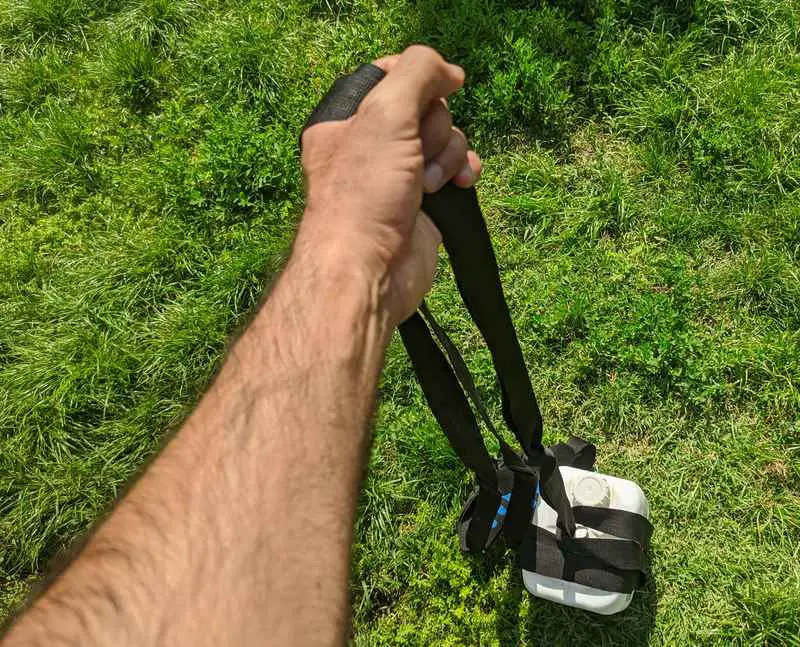
TRX Combo Bicep Workouts
Bodyweight combo exercises combine two or more different exercises into one and alternate between the two. TRX combination exercises are time efficient, improve fitness, burn more calories, improve conditioning, and are ideal for a full-body training program. However, most combo exercises are not suitable for mere strength and hypertrophy programs.
In TRX combination moves, perform one rep of one exercise, and then perform the second rep from another exercise. Hence, a typical set with TRX combo bicep workout is composed of TRX bicep workout paired with another exercise. TRX combo workout can also include more than two exercises. Here are some of the TRX combo bicep workouts, but there are also numerous other ways to create TRX combo bicep workouts.
| TRX Combo Bicep Curl – Upper Body | TRX Combo Bicep Curl – Lower Body |
|---|---|
| TRX Low Row to Bicep Curl | TRX Squat to Bicep Curl |
| TRX High Row to Bicep Curl | |
| TRX Inverted Row to Bicep Curl | |
| TRX Tricep Kickback to TRX Bicep Curl | |
| TRX Reverse Bicep Curl to Overhead Press | |
| TRX Low Row to Bicep Curl to Y Fly | |
| TRX Y Fly to TRX Bicep Clutch | |
| TRX Hinge Pull up to TRX bicep Clutch | |
| TRX Y fly – TRX Bicep Clutch – TRX T Fly – TRX Bicep Curl |
Wrist and grip strength play a crucial role in the quality of other TRX workouts. Learn how to improve grip strength and build your forearm muscle using TRX in TRX forearm exercises.
Can you Build Biceps with TRX?
TRX band bicep workout can be for hypertrophy or as a part of a full-body training regimen for health and wellness. What muscle requires for growth is resistance, nutrition, and rest. The method you implement to create that resistance is not important. For your muscles, it does not matter if you lift a barbell, dumbbell, or a bag of sand. Leveraging the body’s own weight for a TRX bodyweight workout is as practical as weight training.
Nevertheless, the biomechanics of movement in TRX suspension training is different from traditional weight lifting. For a beginner, the sensation of TRX biceps curl is new and abnormal compared to bicep curl with weights. These exceptional conditions impose their own rules of movement on the trainee. As a result, specific training techniques should be tailored for suspension straps.
Biomechanics of Bicep Curl in TRX vs. Weights
Weighted barbell curls have biomechanical limitations that prevent them from pushing biceps to their maximum potential. The arm acts as a third class lever. The amount of pressure on the bicep varies at different angles of the elbow and the maximum pressure is at 90°, because at this angle, the weight is at the furthest distance from the fulcrum (elbow).
At the top of the flexion phase, the effort is minimum; the weight is closer to the fulcrum, and the movement is almost horizontal. So, there is a minor challenge against gravity.
TRX bicep curl does not have this biomechanical limitation. Although angle of the body against the floor changes, with certain techniques such as “intelligent weight,” we can adjust the pressure on demand.
Common Mistakes in TRX Bicep Workouts
- Employing intelligent weight technique to make the movement easy. This technique should only be used when it is necessary. It shall not reduce the maximum load that the muscle can handle.
- In some TRX bicep workouts, at two ends of a movement, the load is not enough. The angle of the body to earth is not enough to create resistance. By employing a suitable strategy, we can create necessary overload at these points.
- An improper starting position in TRX bicep workouts messes up the rest of that set. Set everything right from the beginning, and hold that position throughout the exercise.
- After finding a suitable starting position, focus only on muscle contraction during the exercise. Thinking about body positioning during the exercise reduces the effectiveness of the movement. In bodyweight exercises, there is a correlation between attention and proper form.
- Unconsciously shifting body weight from the target muscle to other muscles such as back, chest or shoulders.
- Using momentum by swinging body weight.
- Not following a predetermined training plan.
- Safety first. Ensure the TRX anchor and all other connecting joints are strong and safe before suspending your body weight.
